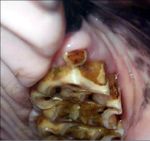Difference between revisions of "Dental Formula - Horse"
m (Text replace - "[[Crown|" to "[[Enamel Organ#Crown|") |
m (Text replace - "[[Root - Anatomy & Physiology|" to "[[Enamel Organ#Root|") |
||
| Line 9: | Line 9: | ||
===Canines=== | ===Canines=== | ||
| − | The canines are '''rudimentary''' and in '''diastema'''. The size of the [[Root | + | The canines are '''rudimentary''' and in '''diastema'''. The size of the [[Enamel Organ#Root|root]] is proportionally larger than the [[Enamel Organ#Crown|crown]]. |
===Molars=== | ===Molars=== | ||
[[Image:Horse Tooth.jpg|thumb|right|150px|Horse tooth - Copyright Malcom Morley]] | [[Image:Horse Tooth.jpg|thumb|right|150px|Horse tooth - Copyright Malcom Morley]] | ||
| − | The molars have enlarged surfaces and higher [[Enamel Organ#Crown|crowns]]. They have delayed [[Root | + | The molars have enlarged surfaces and higher [[Enamel Organ#Crown|crowns]]. They have delayed [[Enamel Organ#Root|root]] development and complicated folding of [[Enamel|enamel]]. |
===Incisors=== | ===Incisors=== | ||
| − | Incisors have high [[Enamel Organ#Crown|crowns]] and folded [[Enamel|enamel]] surfaces. Their [[Root | + | Incisors have high [[Enamel Organ#Crown|crowns]] and folded [[Enamel|enamel]] surfaces. Their [[Enamel Organ#Root|roots]] converge. |
===Premolars=== | ===Premolars=== | ||
Revision as of 23:53, 26 March 2011
Overview
The formula for deciduous teeth: 2 (I3/3 C0/0 P3/3)
The formula for permanent teeth: 2 (I3/3 C1/1 P3-4/3 M3/3)
Canines
The canines are rudimentary and in diastema. The size of the root is proportionally larger than the crown.
Molars
The molars have enlarged surfaces and higher crowns. They have delayed root development and complicated folding of enamel.
Incisors
Incisors have high crowns and folded enamel surfaces. Their roots converge.
Premolars
A horse's Wolf tooth (PM1) is often lacking. Molars and Premolars form a continuous surface. Premolars have a high rate of wear and continually erupt. The upper teeth are wider than the lower. There is no infundibulum in the lower teeth.
Ageing
Horses can be aged by their teeth. At 2 and a half the first permanent incisor will erupt; At 3 and a half the second permanent incisor will erupt and at 4 and a half the third permanent incisor will erupt. Over 5 years of age the folding of the enamel ring (infundibulum) can indicate age. There is a 7 year hook and over 13 years of age a dental star will be present.
The Galvayne's Groove is a brown groove on the upper corner incisor teeth and indicates that the horse is over 10 years old. At 15 the groove will be approximately half way down the tooth; At 20 the groove will run down the whole tooth; Over 20 the grove begins to disappear; At 25 the groove will only be visible on the bottom half of the tooth. At 30 the groove will usually be gone.

